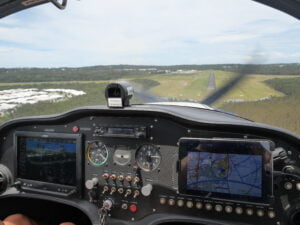Teaching a student how to turn, and to climb and descend is not too hard, but teaching a student to land an aircraft takes time. All flight instructors and students would prefer to learn the art of landing while experiencing as little wind as possible.
Adding wind into the mix makes it harder for the student to master the final landing sequence, particularly if there is any crosswind or gusts of wind. One of the many challenges students face when learning how to land an aircraft is understanding ‘wind gradient’, which is also known as ‘wind shear’. So what is wind gradient?
WIND GRADIENT (OR WIND SHEAR)
Wind gradient is basically a change of wind direction and speed over a vertical or horizontal distance. Wind gradient or shear can exist when two different airstreams meet.
For instance, if an aircraft is climbing through 3,000 feet and the wind at 3,100 feet changes from a westerly wind to a northerly, the difference in the direction of the airflow of these two wind directions in a small amount of distance can cause turbulence known as wind shear.
When landing, the most common form of wind shear is due to the frictional forces of the ground causing the wind speed to decrease as the wind gets closer to ground level.
For instance at 1,000 feet the wind may be 20 knots. However, at just three feet above the ground – due to the frictional forces of the ground – the wind may only be five knots.
This change in wind speed as you get closer to the ground can affect the aircraft on final approach and care must be taken to ensure the pilot is aware of the effect of decreasing wind strength on the aircraft’s airspeed.
Wind shear can also be experienced as a sudden drop in airspeed followed by an increased rate of descent.
And during a climb, or just after takeoff in strong winds, wind shear can also be experienced as a sudden increase in airspeed followed by an increase in rate of climb.
The pilot needs to be aware of the potential sink and loss of airspeed and make sure a healthy attitude and airspeed is always maintained during final approach, with power ready to control the sink rate.
Wind shear can be severe, such as wind near a storm, however for today’s purposes we are only going to discuss light wind shear or wind gradient in relation to final approach to land, when the wind is blowing between 10 to 20kts.
THE FIRST TIME A STUDENT ENCOUNTERS WIND GRADIENT

In nil or little wind, the student has been taught to ensure the aircraft has a stable approach prior to landing. This means a stable indicated airspeed, a stable rate of descent and a stable approach profile.
In nil wind this is normally quite easy to achieve once the student is used to the correct site picture of the runway on final approach.
However if we add 15 kts of headwind the student will notice on final approach that if they keep maintaining the same approach profile the airspeed will start to decrease as the aircraft descends.
This is because the wind strength starts to decrease as the aircraft gets closer to the ground and if the aircraft attitude and approach profile is not changed, the result will be a decrease in indicated airspeed.
When airspeed is decreased (if no pitch change occurs) the lift also decreases and this may also result in an increase in the rate of descent.
If the student does not change the attitude, the airspeed may get dangerously low on final approach.
THE CORRECT PROCEDURE WHEN EXPERIENCING WIND GRADIENT ON FINAL APPROACH

The correct procedure (in a light training aircraft) would be to adjust the attitude (pitch) to maintain the correct approach speed, then adjust power to ensure the rate of descent does not increase (keep in mind that for larger high inertia aircraft, power would be used to correct a reduction in airspeed).
When a student first encounters this (if they have been taught to maintain airspeed with attitude) they will pitch the nose down to maintain a healthy approach speed, however this steepens the approach profile and in most instances they will now be aiming short of the runway.
The only way to correct this is to apply power to change the rate of descent to get back onto the desired approach profile.
When a student pilot first encounters a strong wind gradient on final approach it can be quite frightening, however as they gain experience they learn to anticipate and to keep adjusting the aircraft’s altitude, airspeed and power continuously to maintain the correct approach profile as they descend towards the flare point.
SEVERE WIND SHEAR

Occasionally a pilot and student pilot/instructor may experience a severe wind gradient, where the indicated airspeed reduces dramatically and the rate of descent increases dramatically. In this instance a missed approach (go around) should be initiated immediately.
WIND GRADIENT IS ALWAYS PRESENT WITH WIND
Remember, wind gradient will always be present if there is wind present. In most instances, wind gradient or shear (below 20kts of wind) is easy to manage providing the pilot has had proper training and understands the aircraft and their own limitations.
For more videos, books and quizzes to help you pass your flight tests and become the best pilot you can be, explore the rest of the great content on www.gofly.online




